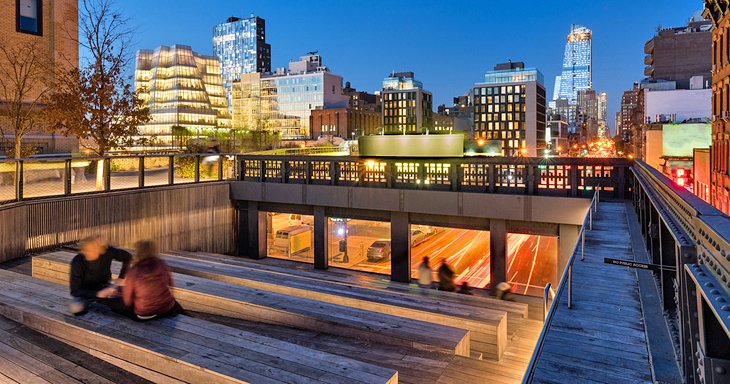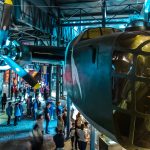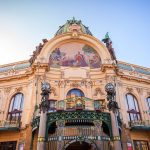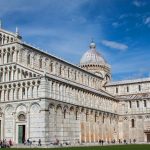New York City comprises 5 boroughs sitting where the Hudson River meets the Atlantic Ocean. At its core is Manhattan, a densely populated borough that’s among the world’s major commercial, financial and cultural centers. Its iconic sites include skyscrapers such as the Empire State Building and sprawling Central Park. Broadway theater is staged in neon-lit Times Square.
Many districts and monuments in New York City are major landmarks, including three of the world’s ten most visited tourist attractions in 2013. A record 66.6 million tourists visited New York City in 2019. Times Square is the brightly illuminated hub of the Broadway Theater District, one of the world’s busiest pedestrian intersections, and a major center of the world’s entertainment industry.Many of the city’s landmarks, skyscrapers, and parks are known around the world, as is the city’s fast pace, spawning the term New York minute. The Empire State Building has become the global standard of reference to describe the height and length of other structures. The Stonewall Inn in Greenwich Village, part of the Stonewall National Monument, is considered the historic epicenter of LGBTQ+ culture and the birthplace of the modern gay rights movement. Manhattan’s real estate market is among the most expensive in the world. Providing continuous 24/7 service and contributing to the nickname The City That Never Sleeps, the New York City Subway is the largest single-operator rapid transit system worldwide, with 472 passenger rail stations; and Penn Station in Midtown Manhattan is the busiest transportation hub in the Western Hemisphere. The city has over 120 colleges and universities, including Columbia University, New York University, and the City University of New York system, which is the largest urban public university system in the United States. Anchored by Wall Street in the Financial District of Lower Manhattan, New York City has been called both the world’s leading financial centerand the most powerful city in the world, and is home to the world’s two largest stock exchanges by total market capitalization, the New York.
1.Central Park

Main attractions include landscapes such as the Ramble and Lake, Hallett Nature Sanctuary, the Jacqueline Kennedy Onassis Reservoir, and Sheep Meadow; amusement attractions such as Wollman Rink, Central Park Carousel, and the Central Park Zoo; formal spaces such as the Central Park Mall and Bethesda Terrace; and the Delacorte Theater. The biologically diverse ecosystem has several hundred species of flora and fauna. Recreational activities include carriage-horse and bicycle tours, bicycling, sports facilities, and concerts and events such as Shakespeare in the Park. Central Park is traversed by a system of roads and walkways and is served by public transportation.
Its size and cultural position make it a model for the world’s urban parks. Its influence earned Central Park the designations of National Historic Landmark in 1963 and of New York City scenic landmark in 1974. Central Park is owned by the New York City Department of Parks and Recreation but has been managed by the Central Park Conservancy since 1998, under a contract with the municipal government in a public–private partnership. The Conservancy, a non-profit organization, raises Central Park’s annual operating budget and is responsible for all basic care of the park.
Besides being a great place to experience a little nature, Central Park has many attractions within its borders, and most of them are free, making it one of the few cheap things to do in NYC. Some of the most popular places to visit include the Belvedere Castle, Strawberry Fields, the Central Park Zoo, and the Lake. If you are exploring the park on your own, start by picking up a map at one of the visitor centers and plot your routing.
2.Rockefeller Center & Top of the Rock Observation Deck

Offering 360 degree views over New York City, Top of the Rock observation deck is located at the top of the Rockefeller Center in New York. Here is a complete guide.
The “deck,” as it’s known, includes three floors, located on the 67th, 69th, and 70th floors. Indoor and outdoor viewing spaces offer spectacular views by day or night. You can buy a Top of the Rock Observation Deck Ticket in advance. These tickets come with a flexible voucher redemption policy, so you can change the date if your plans change or the weather doesn’t cooperate.
How To Get To Top Of The Rock
Top of the Rock observation deck is situated at the top of the Rockefeller Center, 30 Rockefeller Plaza, New York, NY 10020.
By Foot:
The main entrance to Top of the Rock is located on 50th Street between Fifth and Sixth Avenues.
You will find the entrance on the south side of the street, marked by a large red carpet.
By Bus:
The closest public bus stop is West 50th Street/Avenue of the Americas.
By Hop-on Hop-off Bus Tour:
If you take the Hop-on Hop-off Bus Tour you’ll want to jump off at Stop 35 (Rockefeller Plaza).
3.Metropolitan Museum of Art

The Metropolitan Museum of Art of New York City, colloquially “the Met”, is the largest art museum in the Americas. Its permanent collection contains over two million works, divided among 17 curatorial departments.
The Metropolitan Museum of Art was founded in 1870 with its mission to bring art and art education to the American people. The museum’s permanent collection consists of works of art from classical antiquity and ancient Egypt, paintings, and sculptures from nearly all the European masters, and an extensive collection of American and modern art. The Met maintains extensive holdings of African, Asian, Oceanian, Byzantine, and Islamic art. The museum is home to encyclopedic collections of musical instruments, costumes, and accessories, as well as antique weapons and armor from around the world. Several notable interiors, ranging from 1st-century Rome through modern American design, are installed in its galleries.
4.Statue of Liberty

The Statue of Liberty is a colossal neoclassical sculpture on Liberty Island in New York Harbor in New York City, in the United States.
The statue is a figure of Libertas, a robed Roman liberty goddess. She holds a torch above her head with her right hand, and in her left hand carries a tabula ansata inscribed JULY IV MDCCLXXVI (July 4, 1776 in Roman numerals), the date of the U.S. Declaration of Independence. A broken shackle and chain lie at her feet as she walks forward, commemorating the recent national abolition of slavery. After its dedication, the statue became an icon of freedom and of the United States, seen as a symbol of welcome to immigrants arriving by sea.
Bartholdi was inspired by a French law professor and politician, Édouard René de Laboulaye, who is said to have commented in 1865 that any monument raised to U.S. independence would properly be a joint project of the French and American peoples. The Franco-Prussian War delayed progress until 1875, when Laboulaye proposed that the French finance the statue and the United States provide the site and build the pedestal. Bartholdi completed the head and the torch-bearing arm before the statue was fully designed, and these pieces were exhibited for publicity at international expositions.
5.High Line

Template:Attached KML/High Line KML is from Wikidata The High Line is a 1.45-mile-long elevated linear park, greenway and rail trail created on a former New York Central Railroad spur on the west side of Manhattan in New York City.
The park is built on a disused, southern viaduct section of the New York Central Railroad’s West Side Line. Originating in the Meatpacking District, the park runs from Gansevoort Street – three blocks below 14th Street – through Chelsea to the northern edge of the West Side Yard on 34th Street near the Javits Center. The West Side Line formerly extended south to a railroad terminal at Spring Street, just north of Canal Street, and north to 35th Street at the site of the Javits Center. Due to a decline in rail traffic along the rest of the viaduct, it was effectively abandoned in 1980 when the construction of the Javits Center required the demolition of the viaduct’s northernmost portion. The southern portion of the viaduct was demolished in segments during the late 20th century. Repurposing the railway into an urban park began in 2006 and opened in phases during 2009, 2011, and 2014. The Spur, an extension of the High Line that originally connected with the Morgan General Mail Facility at Tenth Avenue and 30th Street, opened on June 4, 2019, as the final part of the park to open.
Since opening in June 2009, the High Line has become an icon of American contemporary landscape architecture. The High Line’s success has inspired cities throughout the United States to redevelop obsolete infrastructure as public space. The park became a tourist attraction and spurred real estate development in adjacent neighborhoods, increasing real-estate values and prices along the route. By September 2014, the park had nearly five million visitors annually, and by 2019, it had eight million visitors per year.
6.Times Square

Times Square is a major commercial intersection, tourist destination, entertainment hub, and neighborhood in Midtown Manhattan, New York City. It is formed by the junction of Broadway, Seventh Avenue, and 42nd Street.
Times Square functions as a town square, but is not geometrically a square; it is closer in shape to a bowtie, with two triangles emanating roughly north and south from 45th Street, where Seventh Avenue intersects Broadway. The area is bounded by West 42nd street, West 47th street, 7th Avenue, and Broadway. Broadway runs diagonally, crossing through the horizontal and vertical street grid of Manhattan laid down by the Commissioners’ Plan of 1811, and that intersection creates the “bowtie” shape of Times Square.
Times Square is the official name of the southern triangle, below 45th Street, but the northern triangle is officially Duffy Square. It was dedicated in 1937 to World War I chaplain Father Francis P. Duffy of the 69th New York Infantry Regiment, and is the site of a memorial to him. There is also a statue of composer and entertainer George M. Cohan, and the TKTS discount ticket booth for Broadway and off-Broadway theaters.
7.Brooklyn Bridge
The Brooklyn Bridge is a hybrid cable-stayed/suspension bridge in New York City, spanning the East River between the boroughs of Manhattan and Brooklyn. Opened on May 24, 1883, the Brooklyn Bridge was the first fixed crossing of the East River.
The Brooklyn Bridge is the southernmost of the four toll-free vehicular bridges connecting Manhattan Island and Long Island, with the Manhattan Bridge, the Williamsburg Bridge, and the Queensboro Bridge to the north. Only passenger vehicles and pedestrian and bicycle traffic are permitted. A major tourist attraction since its opening, the Brooklyn Bridge has become an icon of New York City. Over the years, the bridge has been used as the location of various stunts and performances, as well as several crimes and attacks. The Brooklyn Bridge has been designated a National Historic Landmark, a New York City landmark, and a National Historic Civil Engineering Landmark.
The Brooklyn Bridge, with its Gothic-shaped arches and suspension cables, is one of the city’s most recognizable landmarks and has inspired generations of poets, songwriters, and painters. This historic bridge, spanning the East River from Manhattan to Brooklyn, was completed in 1883 and was the world’s first steel suspension bridge.










